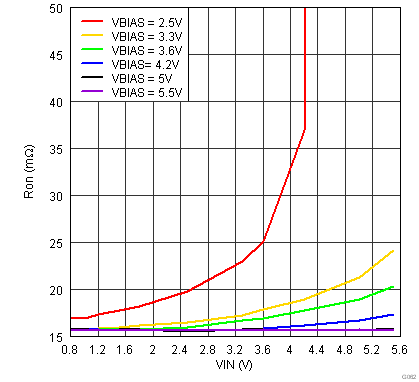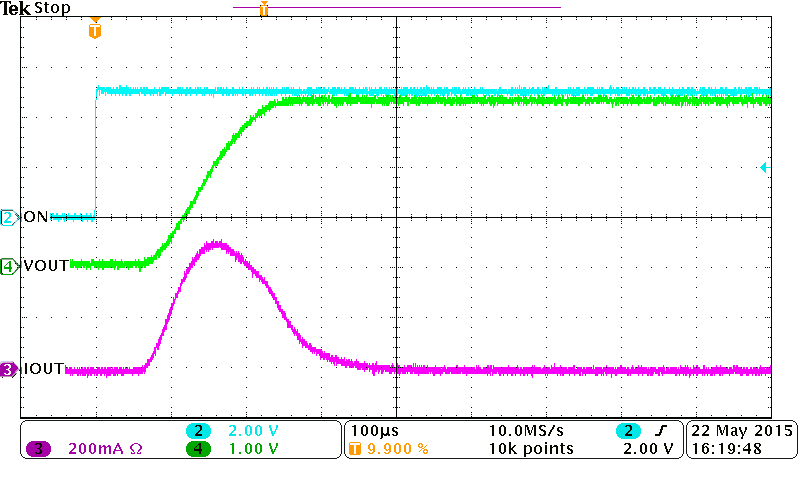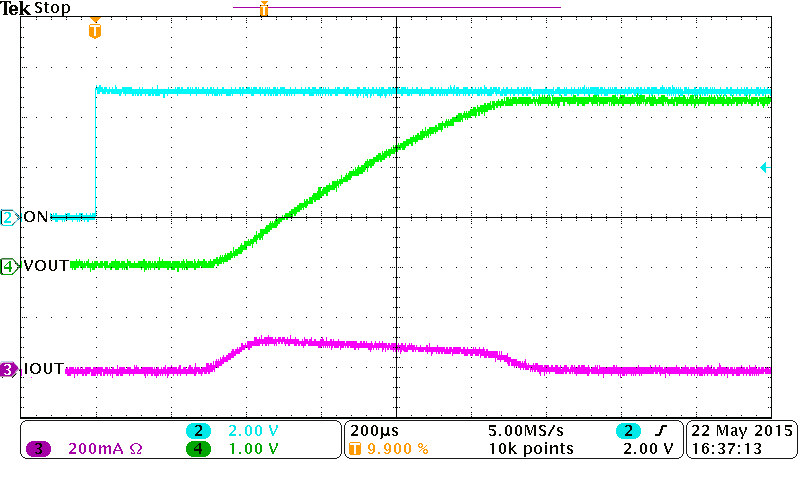SLVSBJ0F August 2012 – August 2016 TPS22965
PRODUCTION DATA.
- 1 Features
- 2 Applications
- 3 Description
- 4 Revision History
- 5 Device Comparison Table
- 6 Pin Configuration and Functions
- 7 Specifications
- 8 Parameter Measurement Information
- 9 Detailed Description
- 10Application and Implementation
- 11Power Supply Recommendations
- 12Layout
- 13Device and Documentation Support
- 14Mechanical, Packaging, and Orderable Information
パッケージ・オプション
メカニカル・データ(パッケージ|ピン)
- DSG|8
サーマルパッド・メカニカル・データ
- DSG|8
発注情報
10 Application and Implementation
NOTE
Information in the following applications sections is not part of the TI component specification, and TI does not warrant its accuracy or completeness. TI’s customers are responsible for determining suitability of components for their purposes. Customers should validate and test their design implementation to confirm system functionality.
10.1 Application Information
10.1.1 ON and OFF Control
The ON pin controls the state of the switch. Asserting ON high enables the switch. ON is active high and has a low threshold, making it capable of interfacing with low-voltage signals. The ON pin is compatible with standard GPIO logic thresholds. It can be used with any microcontroller with 1.2 V or higher GPIO voltage. This pin cannot be left floating and must be driven either high or low for proper functionality.
10.1.2 Input Capacitor (Optional)
To limit the voltage drop on the input supply caused by transient inrush currents when the switch turns on into a discharged load capacitor or short-circuit, a capacitor needs to be placed between VIN and GND. A 1-µF ceramic capacitor, CIN, placed close to the pins, is usually sufficient. Higher values of CIN can be used to further reduce the voltage drop during high current applications. When switching heavy loads, it is recommended to have an input capacitor about 10 times higher than the output capacitor to avoid excessive voltage drop.
10.1.3 Output Capacitor (Optional)
Becuase of the integrated body diode in the NMOS switch, a CIN greater than CL is highly recommended. A CL greater than CIN can cause VOUT to exceed VIN when the system supply is removed. This could result in current flow through the body diode from VOUT to VIN. A CIN to CL ratio of 10 to 1 is recommended for minimizing VIN dip caused by inrush currents during startup; however, a 10 to 1 ratio for capacitance is not required for proper functionality of the device. A ratio smaller than 10 to 1 (such as 1 to 1) could cause slightly more VIN dip upon turn-on due to inrush currents. This can be mitigated by increasing the capacitance on the CT pin for a longer rise time (see the Adjustable Rise Time section).
10.1.4 VIN and VBIAS Voltage Range
For optimal RON performance, make sure VIN ≤ VBIAS. The device is still functional if VIN > VBIAS but it exhibits RON greater than what is listed in the Electrical Characteristics—VBIAS = 5 V table. See Figure 34 for an example of a typical device. Notice the increasing RON as VIN exceeds VBIAS voltage. Never exceed the maximum voltage rating for VIN and VBIAS.

| TA = 25 °C | IOUT = –200 mA |
10.2 Typical Application
This application demonstrates how the TPS22965x can be used to power downstream modules.
 Figure 35. Powering a Downstream Module
Figure 35. Powering a Downstream Module
10.2.1 Design Requirements
Table 3 shows the design parameters.
Table 3. Design Parameters
| DESIGN PARAMETER | EXAMPLE VALUE |
|---|---|
| VIN | 3.3 V |
| VBIAS | 5 V |
| CL | 22 µF |
| Maximum Acceptable Inrush Current | 400 mA |
10.2.2 Detailed Design Procedure
10.2.2.1 Inrush Current
When the switch is enabled, the output capacitors must be charged up from 0 V to the set value (3.3 V in this example). This charge arrives in the form of inrush current. Inrush current can be calculated using Equation 2.
where
- C is the output capacitance
- dV is the output voltage
- dt is the rise time
The TPS22965x offers adjustable rise time for VOUT. This feature allows the user to control the inrush current during turn-on. The appropriate rise time can be calculated using the design requirements and the inrush current equation. See Equation 3 and Equation 4.
To ensure an inrush current of less than 400 mA, choose a CT value that yields a rise time of more than 181.5 µs. See the oscilloscope captures in the Application Curves section for an example of how the CT capacitor can be used to reduce inrush current.
10.2.2.2 Thermal Considerations
The maximum IC junction temperature must be restricted to 125°C under normal operating conditions. To calculate the maximum allowable dissipation, PD(max) for a given output current and ambient temperature, use Equation 5 as a guideline:

where
- PD(max) is the maximum allowable power dissipation
- TJ(max) is the maximum allowable junction temperature (125°C for the TPS22965x)
- TA is the ambient temperature of the device
- ΘJA = junction to air thermal impedance. See the Thermal Information table. This parameter is highly dependent upon board layout.
See Figure 38, notice that the thermal vias are located under the exposed thermal pad of the device. This allows for thermal diffusion away from the device.
10.2.3 Application Curves

| VBIAS = 5 V | VIN = 3.3 V | CL = 22 µF |

| VBIAS = 5 V | VIN = 3.3 V | CL = 22 µF |